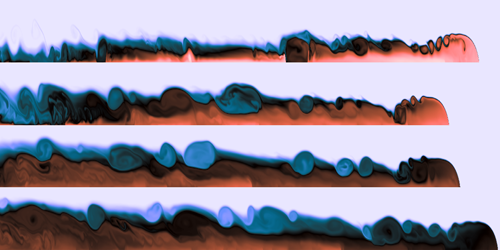How Freshwater Mixes in a Winter Lake
In late winter in the mountains of British Columbia, water from the Thompson River enters Kamloops Lake and flows like an avalanche along the surface. Upon mixing with the lake water, the influx can increase in density, plunging it to the lake’s bottom, where it flows downslope. Simulations by Andrew Grace of the University of Waterloo, Canada, and his colleagues now describe how the evolution of these currents depends on the temperature contrast between the two bodies of water [1].
While most fluids get denser as they approach their freezing point, freshwater reaches its maximum density at 4 °C. If two freshwater parcels are, respectively, above and below this temperature, their mixing creates a fluid parcel that’s denser than the average of the two. When this mixing occurs because of relatively warm river water entering a cold lake—such as at Kamloops Lake—the resulting dense water sinks, warming the lake from the bottom up. This may result in a dense, warm-water mass that affects the circulation of the lake water.
Grace and his colleagues modeled the dynamics of such a scenario, determining how far an intruding flow could reach before it generated denser water via mixing. In some cases, its density increased sufficiently to sink and, ultimately, form a second current along the lake bottom. The team developed a framework that described the bottom current’s behavior.
The researchers say that a better understanding of circulation patterns in river–lake systems could help to predict how nutrients and pollutants spread and how power-plant wastewater affects the local environment.
–Rachel Berkowitz
Rachel Berkowitz is a Corresponding Editor for Physics Magazine based in Vancouver, Canada.
References
- A. P. Grace et al., “Gravity currents in the cabbeling regime,” Phys. Rev. Fluids 8, 014502 (2023).




